Calibration of Integrated Low-Cost Environmental Sensors for Urban Air Temperature Based on Machine Learning
Abstract
1. Introduction
2. Materials and Methods
2.1. Data Acquisition
2.2. Methods
2.3. Evaluation Metrics
3. Results
3.1. Differences Between Sensors and Stations
3.2. Calibration and Verification Results
3.3. Differences in Multiple Scenes
3.4. Performance of High Values
4. Discussion
5. Conclusions
Author Contributions
Funding
Institutional Review Board Statement
Informed Consent Statement
Data Availability Statement
Acknowledgments
Conflicts of Interest
References
- Yamamoto, K.; Togami, T.; Yamaguchi, N.; Ninomiya, S. Machine Learning-Based Calibration of Low-Cost Air Temperature Sensors Using Environmental Data. Sensors 2017, 17, 1290. [Google Scholar] [CrossRef] [PubMed]
- Swamy, G.; Erva, R.R.; Pujari, M.; Kodavaty, J. An Overview on Patterns, Monitoring, and Modeling of the Urban Climate Changes. Phys. Chem. Earth Parts A/B/C 2024, 135, 103625. [Google Scholar] [CrossRef]
- Hernández-Gordillo, A.; Ruiz-Correa, S.; Robledo-Valero, V.; Hernández-Rosales, C.; Arriaga, S. Recent Advancements in Low-Cost Portable Sensors for Urban and Indoor Air Quality Monitoring. Air Qual. Atmos. Health 2021, 14, 1931–1951. [Google Scholar] [CrossRef]
- Kolokotroni, M.; Giridharan, R. Urban Heat Island Intensity in London: An Investigation of the Impact of Physical Characteristics on Changes in Outdoor Air Temperature during Summer. Sol. Energy 2008, 82, 986–998. [Google Scholar] [CrossRef]
- Gago, E.J.; Roldan, J.; Pacheco-Torres, R.; Ordóñez, J. The City and Urban Heat Islands: A Review of Strategies to Mitigate Adverse Effects. Renew. Sustain. Energy Rev. 2013, 25, 749–758. [Google Scholar] [CrossRef]
- Evans, B.; Elisei, P.; Rosenfeld, O.; Roll, G.; Figueiredo, A.; Keiner, M. HABITAT III—Toward a New Urban Agenda. Disp—Plan. Rev. 2016, 52, 86–91. [Google Scholar] [CrossRef]
- Voukkali, I.; Papamichael, I.; Loizia, P.; Zorpas, A.A. Urbanization and Solid Waste Production: Prospects and Challenges. Env. Sci. Pollut. Res. 2024, 31, 17678–17689. [Google Scholar] [CrossRef]
- Jamei, E.; Rajagopalan, P.; Seyedmahmoudian, M.; Jamei, Y. Review on the Impact of Urban Geometry and Pedestrian Level Greening on Outdoor Thermal Comfort. Renew. Sustain. Energy Rev. 2016, 54, 1002–1017. [Google Scholar] [CrossRef]
- Wolkoff, P. Indoor Air Humidity, Air Quality, and Health—An Overview. Int. J. Hyg. Environ. Health 2018, 221, 376–390. [Google Scholar] [CrossRef]
- Ryan, I.; Deng, X.; Thurston, G.; Khwaja, H.; Romeiko, X.; Zhang, W.; Marks, T.; Yu, F.; Lin, S. Measuring Students’ Exposure to Temperature and Relative Humidity in Various Indoor Environments and across Seasons Using Personal Air Monitors. Hyg. Environ. Health Adv. 2022, 4, 100029. [Google Scholar] [CrossRef]
- Aram, F.; Higueras García, E.; Solgi, E.; Mansournia, S. Urban Green Space Cooling Effect in Cities. Heliyon 2019, 5, e01339. [Google Scholar] [CrossRef] [PubMed]
- Yu, Z.; Chen, S.; Wong, N.H.; Ignatius, M.; Deng, J.; He, Y.; Hii, D.J.C. Dependence between Urban Morphology and Outdoor Air Temperature: A Tropical Campus Study Using Random Forests Algorithm. Sustain. Cities Soc. 2020, 61, 102200. [Google Scholar] [CrossRef]
- Wong, N.H.; Tan, C.L.; Kolokotsa, D.D.; Takebayashi, H. Greenery as a Mitigation and Adaptation Strategy to Urban Heat. Nat. Rev. Earth Env. 2021, 2, 166–181. [Google Scholar] [CrossRef]
- Schmidt, V. Urban Morphology as a Key Parameter for Mitigating Urban Heat?—A Literature Review. IOP Conf. Ser. Earth Environ. Sci. 2024, 1363, 012074. [Google Scholar] [CrossRef]
- AghaKouchak, A.; Farahmand, A.; Melton, F.S.; Teixeira, J.; Anderson, M.C.; Wardlow, B.D.; Hain, C.R. Remote Sensing of Drought: Progress, Challenges and Opportunities. Rev. Geophys. 2015, 53, 452–480. [Google Scholar] [CrossRef]
- Aflaki, A.; Mirnezhad, M.; Ghaffarianhoseini, A.; Ghaffarianhoseini, A.; Omrany, H.; Wang, Z.-H.; Akbari, H. Urban Heat Island Mitigation Strategies: A State-of-the-Art Review on Kuala Lumpur, Singapore and Hong Kong. Cities 2017, 62, 131–145. [Google Scholar] [CrossRef]
- Tikle, S.; Anand, V.; Das, S. Geospatial Practices for Airpollution and Meteorological Monitoring, Prediction, and Forecasting. In Geospatial Practices in Natural Resources Management; Shit, P.K., Dutta, D., Das, T.K., Das, S., Bhunia, G.S., Das, P., Sahoo, S., Eds.; Springer International Publishing: Cham, Switzerland, 2024; pp. 549–566. ISBN 978-3-031-38004-4. [Google Scholar]
- Morawska, L.; Thai, P.K.; Liu, X.; Asumadu-Sakyi, A.; Ayoko, G.; Bartonova, A.; Bedini, A.; Chai, F.; Christensen, B.; Dunbabin, M.; et al. Applications of Low-Cost Sensing Technologies for Air Quality Monitoring and Exposure Assessment: How Far Have They Gone? Environ. Int. 2018, 116, 286–299. [Google Scholar] [CrossRef]
- Kang, Y.; Aye, L.; Ngo, T.D.; Zhou, J. Performance Evaluation of Low-Cost Air Quality Sensors: A Review. Sci. Total Environ. 2022, 818, 151769. [Google Scholar] [CrossRef]
- Chow, J.C. Measurement Methods to Determine Compliance with Ambient Air Quality Standards for Suspended Particles. J. Air Waste Manag. Assoc. 1995, 45, 320–382. [Google Scholar] [CrossRef]
- Chong, C.-Y.; Kumar, S.P. Sensor Networks: Evolution, Opportunities, and Challenges. Proc. IEEE 2003, 91, 1247–1256. [Google Scholar] [CrossRef]
- Idrees, Z.; Zheng, L. Low Cost Air Pollution Monitoring Systems: A Review of Protocols and Enabling Technologies. J. Ind. Inf. Integr. 2020, 17, 100123. [Google Scholar] [CrossRef]
- Kumar, P.; Morawska, L.; Martani, C.; Biskos, G.; Neophytou, M.; Di Sabatino, S.; Bell, M.; Norford, L.; Britter, R. The Rise of Low-Cost Sensing for Managing Air Pollution in Cities. Environ. Int. 2015, 75, 199–205. [Google Scholar] [CrossRef] [PubMed]
- Crilley, L.R.; Shaw, M.; Pound, R.; Kramer, L.J.; Price, R.; Young, S.; Lewis, A.C.; Pope, F.D. Evaluation of a Low-Cost Optical Particle Counter (Alphasense OPC-N2) for Ambient Air Monitoring. Atmos. Meas. Tech. 2018, 11, 709–720. [Google Scholar] [CrossRef]
- Ródenas García, M.; Spinazzé, A.; Branco, P.T.; Borghi, F.; Villena, G.; Cattaneo, A.; Di Gilio, A.; Mihucz, V.G.; Gómez Álvarez, E.; Lopes, S.I.; et al. Review of Low-Cost Sensors for Indoor Air Quality: Features and Applications. Appl. Spectrosc. Rev. 2022, 57, 747–779. [Google Scholar] [CrossRef]
- Radić, J.; Brkić, M.; Keser, T.; Obrovski, B.; Mihajlović, I.; Toskić, M.V. Distributed Wireless IoT Based Sensing and Quality Monitoring System in Protection of Wetlands Groundwater Areas. Meas. Sci. Technol. 2024, 35, 125110. [Google Scholar] [CrossRef]
- Gao, M.; Cao, J.; Seto, E. A Distributed Network of Low-Cost Continuous Reading Sensors to Measure Spatiotemporal Variations of PM2.5 in Xi’an, China. Environ. Pollut. 2015, 199, 56–65. [Google Scholar] [CrossRef]
- Heimann, I.; Bright, V.B.; McLeod, M.W.; Mead, M.I.; Popoola, O.A.M.; Stewart, G.B.; Jones, R.L. Source Attribution of Air Pollution by Spatial Scale Separation Using High Spatial Density Networks of Low Cost Air Quality Sensors. Atmos. Environ. 2015, 113, 10–19. [Google Scholar] [CrossRef]
- Mead, M.I.; Popoola, O.A.M.; Stewart, G.B.; Landshoff, P.; Calleja, M.; Hayes, M.; Baldovi, J.J.; McLeod, M.W.; Hodgson, T.F.; Dicks, J.; et al. The Use of Electrochemical Sensors for Monitoring Urban Air Quality in Low-Cost, High-Density Networks. Atmos. Environ. 2013, 70, 186–203. [Google Scholar] [CrossRef]
- Zheng, T.; Bergin, M.H.; Johnson, K.K.; Tripathi, S.N.; Shirodkar, S.; Landis, M.S.; Sutaria, R.; Carlson, D.E. Field Evaluation of Low-Cost Particulate Matter Sensors in High- and Low-Concentration Environments. Atmos. Meas. Tech. 2018, 11, 4823–4846. [Google Scholar] [CrossRef]
- Rai, A.C.; Kumar, P.; Pilla, F.; Skouloudis, A.N.; Di Sabatino, S.; Ratti, C.; Yasar, A.; Rickerby, D. End-User Perspective of Low-Cost Sensors for Outdoor Air Pollution Monitoring. Sci. Total Environ. 2017, 607–608, 691–705. [Google Scholar] [CrossRef]
- Castell, N.; Dauge, F.R.; Schneider, P.; Vogt, M.; Lerner, U.; Fishbain, B.; Broday, D.; Bartonova, A. Can Commercial Low-Cost Sensor Platforms Contribute to Air Quality Monitoring and Exposure Estimates? Environ. Int. 2017, 99, 293–302. [Google Scholar] [CrossRef] [PubMed]
- Abdulkarem, M.; Samsudin, K.; Rokhani, F.Z.; Rasid, M.F.A. Wireless Sensor Network for Structural Health Monitoring: A Contemporary Review of Technologies, Challenges, and Future Direction. Struct. Health Monit. 2020, 19, 693–735. [Google Scholar] [CrossRef]
- Jiao, W.; Hagler, G.; Williams, R.; Sharpe, R.; Brown, R.; Garver, D.; Judge, R.; Caudill, M.; Rickard, J.; Davis, M.; et al. Community Air Sensor Network (CAIRSENSE) Project: Evaluation of Low-Cost Sensor Performance in a Suburban Environment in the Southeastern United States. Atmos. Meas. Tech. 2016, 9, 5281–5292. [Google Scholar] [CrossRef]
- Maag, B.; Zhou, Z.; Thiele, L. A Survey on Sensor Calibration in Air Pollution Monitoring Deployments. IEEE Internet Things J. 2018, 5, 4857–4870. [Google Scholar] [CrossRef]
- Karagulian, F.; Barbiere, M.; Kotsev, A.; Spinelle, L.; Gerboles, M.; Lagler, F.; Redon, N.; Crunaire, S.; Borowiak, A. Review of the Performance of Low-Cost Sensors for Air Quality Monitoring. Atmosphere 2019, 10, 506. [Google Scholar] [CrossRef]
- Venkatraman Jagatha, J.; Klausnitzer, A.; Chacón-Mateos, M.; Laquai, B.; Nieuwkoop, E.; van der Mark, P.; Vogt, U.; Schneider, C. Calibration Method for Particulate Matter Low-Cost Sensors Used in Ambient Air Quality Monitoring and Research. Sensors 2021, 21, 3960. [Google Scholar] [CrossRef]
- González Rivero, R.A.; Schalm, O.; Alvarez Cruz, A.; Hernández Rodríguez, E.; Morales Pérez, M.C.; Alejo Sánchez, D.; Martinez Laguardia, A.; Jacobs, W.; Hernández Santana, L. Relevance and Reliability of Outdoor SO2 Monitoring in Low-Income Countries Using Low-Cost Sensors. Atmosphere 2023, 14, 912. [Google Scholar] [CrossRef]
- Zimmerman, N.; Presto, A.A.; Kumar, S.P.N.; Gu, J.; Hauryliuk, A.; Robinson, E.S.; Robinson, A.L.; Subramanian, R. A Machine Learning Calibration Model Using Random Forests to Improve Sensor Performance for Lower-Cost Air Quality Monitoring. Atmos. Meas. Tech. 2018, 11, 291–313. [Google Scholar] [CrossRef]
- Liang, L. Calibrating Low-Cost Sensors for Ambient Air Monitoring: Techniques, Trends, and Challenges. Environ. Res. 2021, 197, 111163. [Google Scholar] [CrossRef]
- Villanueva, E.; Espezua, S.; Castelar, G.; Diaz, K.; Ingaroca, E. Smart Multi-Sensor Calibration of Low-Cost Particulate Matter Monitors. Sensors 2023, 23, 3776. [Google Scholar] [CrossRef]
- Wang, A.; Machida, Y.; deSouza, P.; Mora, S.; Duhl, T.; Hudda, N.; Durant, J.L.; Duarte, F.; Ratti, C. Leveraging Machine Learning Algorithms to Advance Low-Cost Air Sensor Calibration in Stationary and Mobile Settings. Atmos. Environ. 2023, 301, 119692. [Google Scholar] [CrossRef]
- Li, J.; Zhang, H.; Chao, C.-Y.; Chien, C.-H.; Wu, C.-Y.; Luo, C.H.; Chen, L.-J.; Biswas, P. Integrating Low-Cost Air Quality Sensor Networks with Fixed and Satellite Monitoring Systems to Study Ground-Level PM2.5. Atmos. Environ. 2020, 223, 117293. [Google Scholar] [CrossRef]
- Kramer, A.L.; Liu, J.; Li, L.; Connolly, R.; Barbato, M.; Zhu, Y. Environmental Justice Analysis of Wildfire-Related PM2.5 Exposure Using Low-Cost Sensors in California. Sci. Total Environ. 2023, 856, 159218. [Google Scholar] [CrossRef]
- Stampfer, O.; Zuidema, C.; Allen, R.W.; Fox, J.; Sampson, P.; Seto, E.; Karr, C.J. Practical Considerations for Using Low-Cost Sensors to Assess Wildfire Smoke Exposure in School and Childcare Settings. J. Expo. Sci. Env. Epidemiol. 2024, 35, 157–168. [Google Scholar] [CrossRef]
- Liu, H.; Wang, B.; Sun, X.; Li, T.; Liu, Q.; Guo, Y. DCSCS: A Novel Approach to Improve Data Accuracy for Low Cost Meteorological Sensor Networks. Inf. Technol. J. 2014, 13, 1640–1647. [Google Scholar] [CrossRef]
- Grykałowska, A.; Kowal, A.; Szmyrka-Grzebyk, A. The Basics of Calibration Procedure and Estimation of Uncertainty Budget for Meteorological Temperature Sensors. Meteorol. Appl. 2015, 22, 867–872. [Google Scholar] [CrossRef]
- Sun, X.; Yan, S.; Wang, B.; Xia, L.; Liu, Q.; Zhang, H. Air Temperature Error Correction Based on Solar Radiation in an Economical Meteorological Wireless Sensor Network. Sensors 2015, 15, 18114–18139. [Google Scholar] [CrossRef]
- Tang, R.; Ning, Y.; Li, C.; Feng, W.; Chen, Y.; Xie, X. Numerical Forecast Correction of Temperature and Wind Using a Single-Station Single-Time Spatial LightGBM Method. Sensors 2022, 22, 193. [Google Scholar] [CrossRef]
- Cao, Q.; Wu, Y.; Yang, J.; Yin, J. Greenhouse Temperature Prediction Based on Time-Series Features and LightGBM. Appl. Sci. 2023, 13, 1610. [Google Scholar] [CrossRef]
- Nan, F.; Zeng, C.; Ni, G.; Zhou, M.; Shen, H. Development and Validation of Low-Cost IoT Environmental Sensors: A Case Study in Wuhan, China. IEEE Sens. J. 2023, 23, 3069–3078. [Google Scholar] [CrossRef]
- Ke, G.; Meng, Q.; Finley, T.; Wang, T.; Chen, W.; Ma, W.; Ye, Q.; Liu, T.-Y. LightGBM: A Highly Efficient Gradient Boosting Decision Tree. In Proceedings of the Advances in Neural Information Processing Systems, Long Beach, CA, USA, 4–9 December 2017; Curran Associates, Inc.: Red Hook, NY, USA, 2017; Volume 30. [Google Scholar]

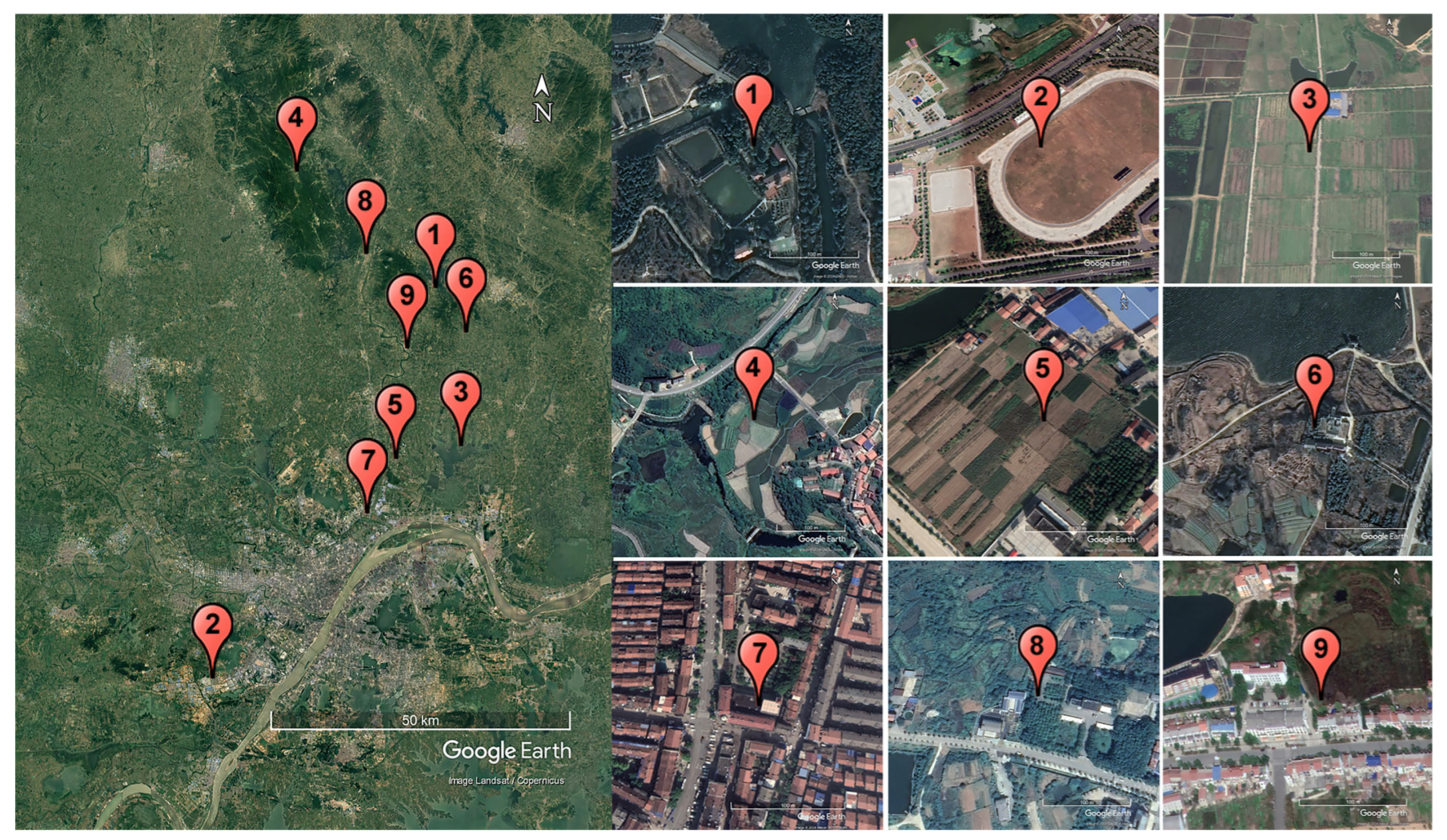
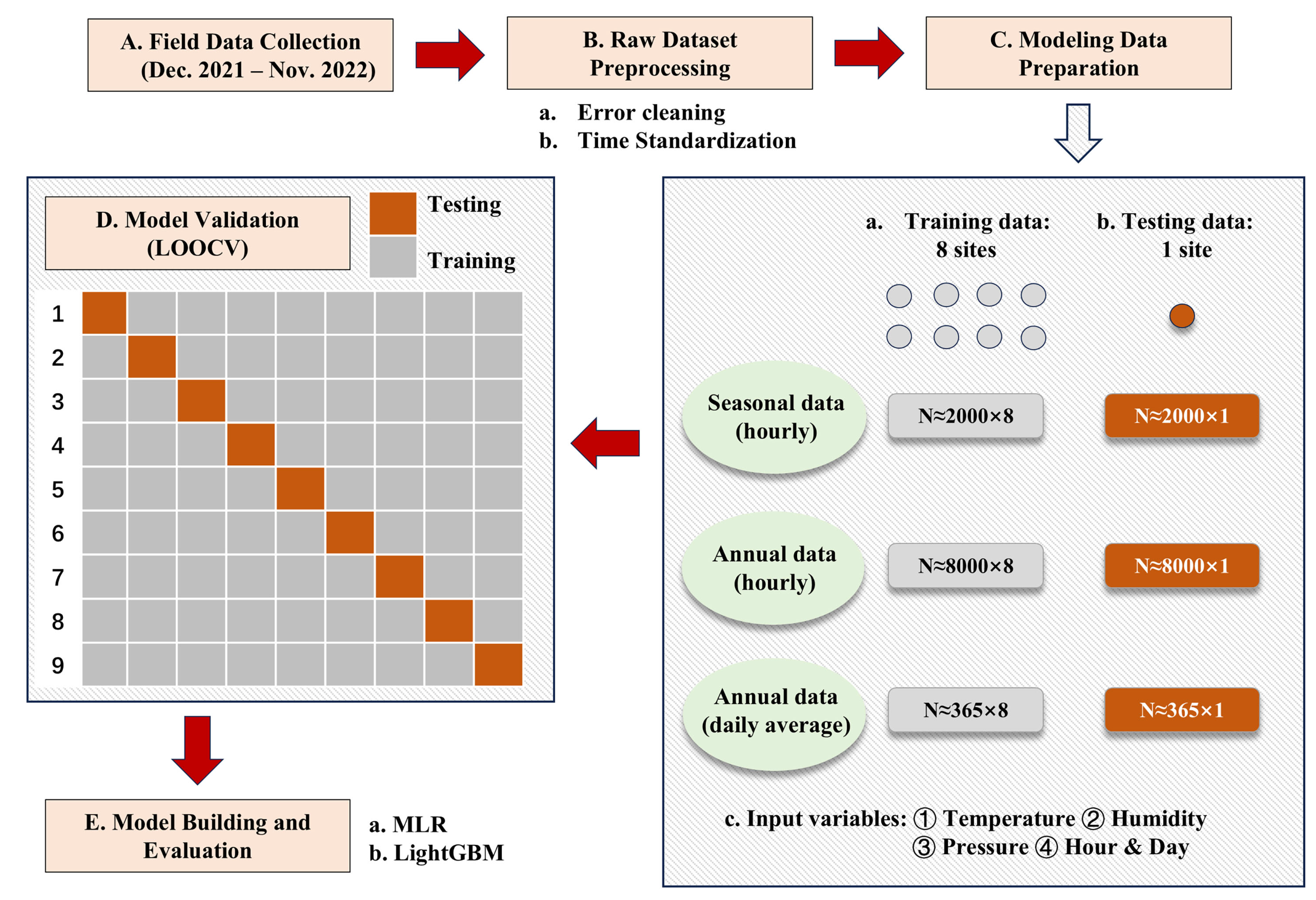
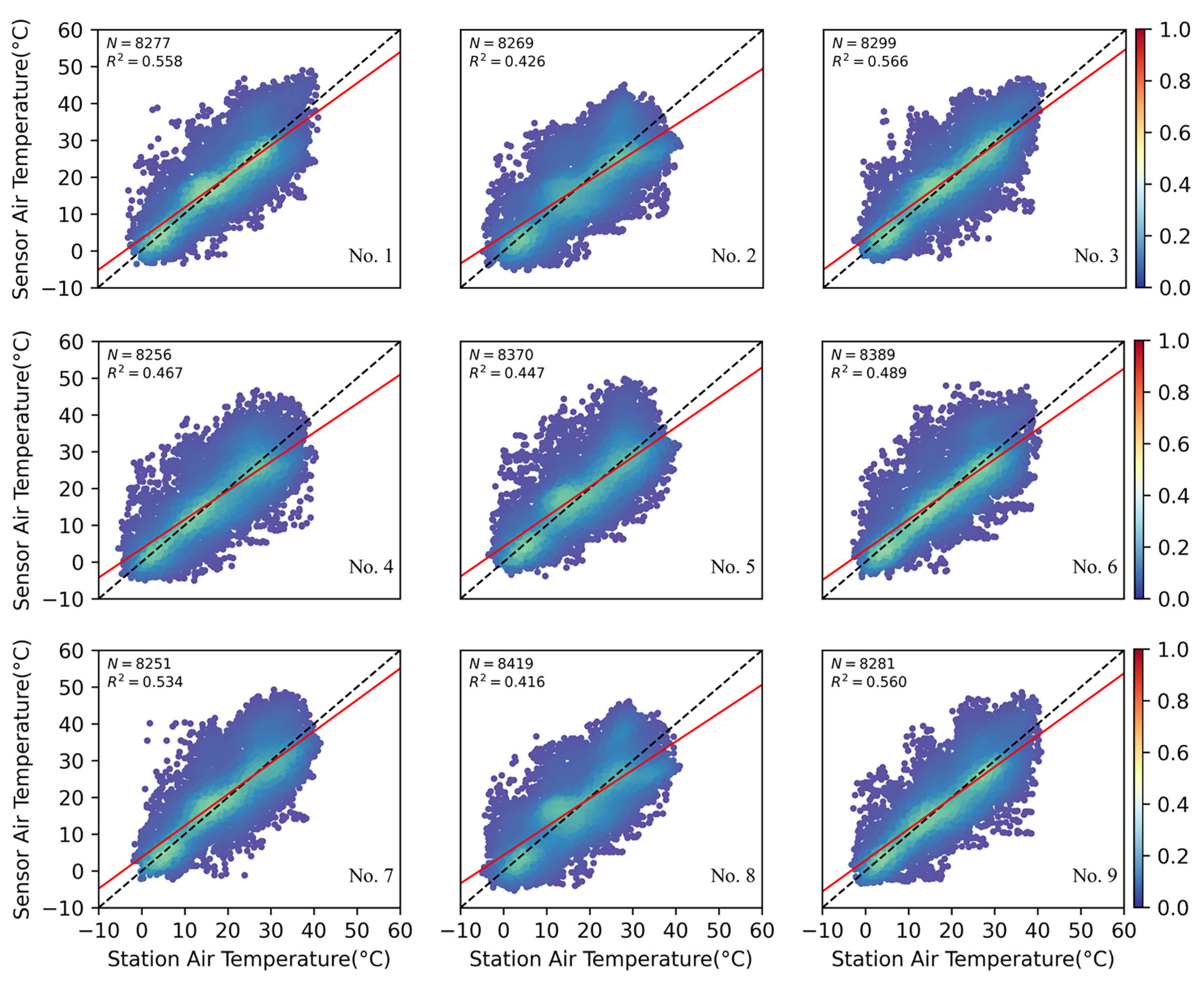
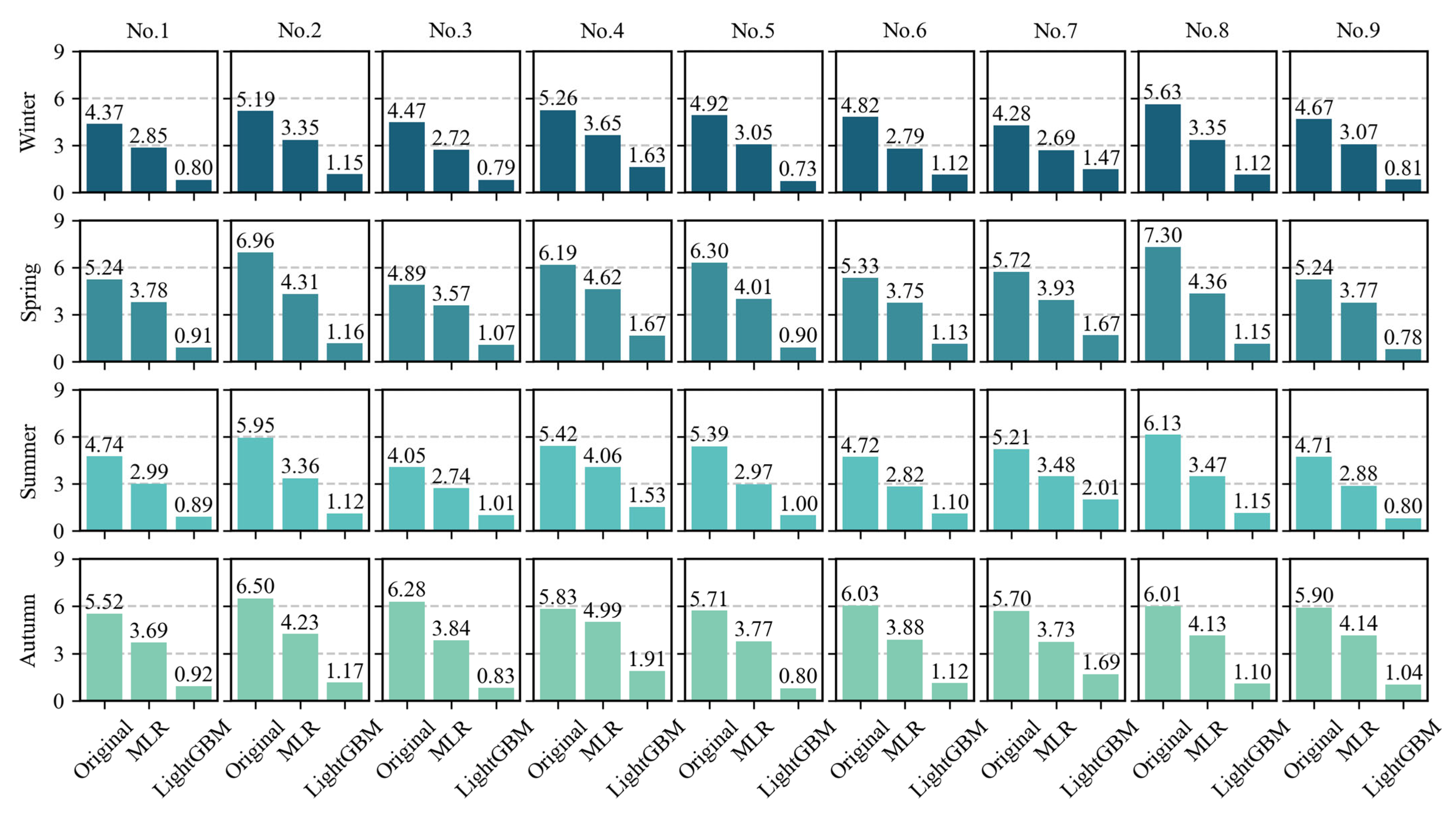
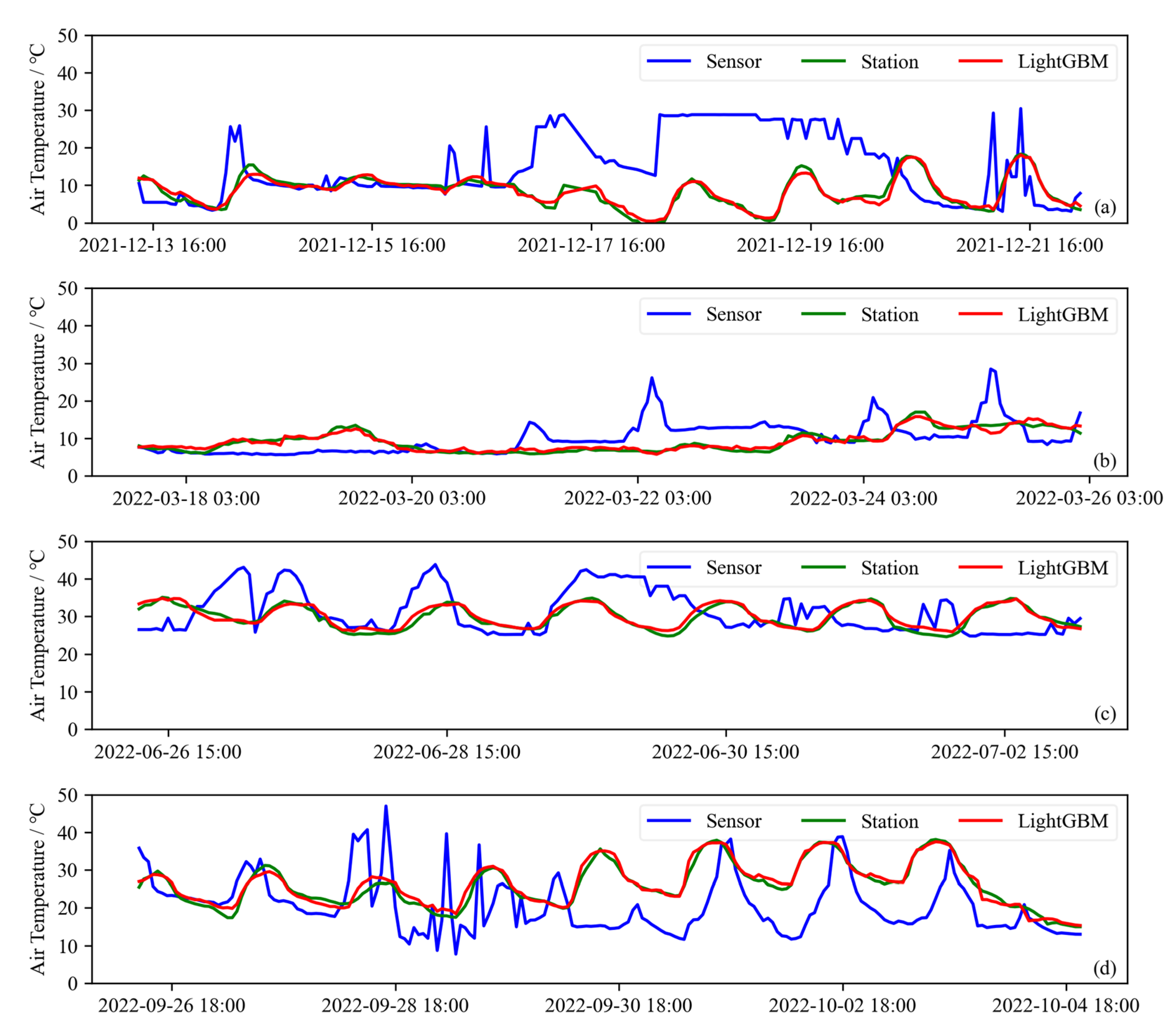




| Type | Manufacturers | Model | Precision |
|---|---|---|---|
| Temperature | Silicon Labs (Austin, TX, USA) | Si705x | ±0.1 °C |
| Humidity | Sensirion (Stäfa, Zurich Canton, Switzerland) | SHT35 | ±1.5% RH |
| Pressure | Bosch (Gerlingen, Baden-Württemberg, Germany) | BMP280 | ±0.12 hPa |
| No. | Station | Sensor | Surface Type |
|---|---|---|---|
| 1 | XJS | 005 | Woodlands |
| 2 | SXY | 019 | Grasslands |
| 3 | LZJ | 021 | Cultivated land |
| 4 | HPYQ | 139 | Cultivated land |
| 5 | HPDT | 166 | Cultivated land |
| 6 | CZJ | 175 | Woodlands |
| 7 | HPSK | 249 | Built-up areas |
| 8 | CXL | 283 | Shrubland |
| 9 | WJH | 286 | Shrubland |
| No. | Type | Min | Max | Median | Mean |
|---|---|---|---|---|---|
| 1 | Sensor | −3.526 | 49.005 | 18.021 | 18.513 |
| Station | −3.000 | 41.000 | 18.200 | 18.091 | |
| 2 | Sensor | −5.146 | 45.088 | 17.531 | 17.463 |
| Station | −4.900 | 40.900 | 17.800 | 17.635 | |
| 3 | Sensor | −2.650 | 46.754 | 19.047 | 19.543 |
| Station | −2.900 | 40.900 | 19.000 | 18.814 | |
| 4 | Sensor | −5.052 | 46.685 | 16.658 | 17.036 |
| Station | −5.400 | 40.400 | 17.150 | 16.995 | |
| 5 | Sensor | −3.827 | 49.813 | 18.364 | 18.934 |
| Station | −3.500 | 40.700 | 18.300 | 18.173 | |
| 6 | Sensor | −4.153 | 48.334 | 18.510 | 18.416 |
| Station | −2.800 | 40.400 | 18.600 | 18.401 | |
| 7 | Sensor | −2.312 | 49.289 | 20.045 | 20.453 |
| Station | −1.900 | 41.500 | 19.700 | 19.540 | |
| 8 | Sensor | −5.346 | 46.116 | 17.357 | 17.812 |
| Station | −4.900 | 40.900 | 17.500 | 17.488 | |
| 9 | Sensor | −3.439 | 48.572 | 17.685 | 18.350 |
| Station | −3.200 | 40.800 | 18.500 | 18.262 |
| Calibrated | Model | R2 (LightGBM) | Surface Type | Distance/km |
|---|---|---|---|---|
| No. 5 Sensor Cultivated land R2 (Original): 0.447 | No. 7 | 0.936 | Built-up areas | 10 |
| No. 3 | 0.956 | Cultivated land | 11 | |
| No. 9 | 0.950 | Shrubland | 18 | |
| No. 6 | 0.915 | Woodlands | 24 | |
| No. 1 | 0.942 | Woodlands | 29 | |
| No. 8 | 0.941 | Shrubland | 35 | |
| No. 2 | 0.915 | Grasslands | 48 | |
| No. 4 | 0.823 | Cultivated land | 50 | |
| No. 6 Sensor Woodlands R2 (Original): 0.489 | No. 1 | 0.946 | Woodlands | 9 |
| No. 9 | 0.933 | Shrubland | 10 | |
| No. 3 | 0.919 | Cultivated land | 19 | |
| No. 8 | 0.925 | Shrubland | 21 | |
| No. 5 | 0.896 | Cultivated land | 24 | |
| No. 7 | 0.898 | Built-up areas | 34 | |
| No. 4 | 0.917 | Cultivated land | 39 | |
| No. 2 | 0.979 | Grasslands | 72 | |
| No. 8 Sensor Shrubland R2 (Original): 0.416 | No. 1 | 0.935 | Woodlands | 13 |
| No. 9 | 0.937 | Shrubland | 17 | |
| No. 4 | 0.917 | Cultivated land | 18 | |
| No. 6 | 0.934 | Woodlands | 21 | |
| No. 5 | 0.929 | Cultivated land | 35 | |
| No. 3 | 0.916 | Cultivated land | 36 | |
| No. 7 | 0.888 | Built-up areas | 43 | |
| No. 2 | 0.934 | Grasslands | 75 |
| Value Range/°C | Sample Size | Original | LightGBM-Calibrated | ||||
|---|---|---|---|---|---|---|---|
| R2 | MAE | RMSE | R2 | MAE | RMSE | ||
| [−6, 2] | 4929 | −1.246 | 4.724 | 6.159 | 0.785 | 1.503 | 1.905 |
| [2, 10] | 13,354 | 0.110 | 3.884 | 5.454 | 0.874 | 1.569 | 2.051 |
| [10, 18] | 18,578 | −0.015 | 5.134 | 6.672 | 0.873 | 1.819 | 2.357 |
| [18, 26] | 18,029 | 0.116 | 5.393 | 6.926 | 0.906 | 1.752 | 2.257 |
| [26, 34] | 13,633 | −0.224 | 5.705 | 7.656 | 0.904 | 1.656 | 2.147 |
| [34, 42] | 5285 | −2.389 | 9.512 | 11.113 | 0.877 | 1.636 | 2.114 |
| [42, 50] | 1003 | −6.653 | 12.691 | 13.698 | 0.839 | 1.530 | 1.984 |
Disclaimer/Publisher’s Note: The statements, opinions and data contained in all publications are solely those of the individual author(s) and contributor(s) and not of MDPI and/or the editor(s). MDPI and/or the editor(s) disclaim responsibility for any injury to people or property resulting from any ideas, methods, instructions or products referred to in the content. |
© 2025 by the authors. Licensee MDPI, Basel, Switzerland. This article is an open access article distributed under the terms and conditions of the Creative Commons Attribution (CC BY) license (https://creativecommons.org/licenses/by/4.0/).
Share and Cite
Nan, F.; Zeng, C.; Shen, H.; Lin, L. Calibration of Integrated Low-Cost Environmental Sensors for Urban Air Temperature Based on Machine Learning. Sensors 2025, 25, 3398. https://doi.org/10.3390/s25113398
Nan F, Zeng C, Shen H, Lin L. Calibration of Integrated Low-Cost Environmental Sensors for Urban Air Temperature Based on Machine Learning. Sensors. 2025; 25(11):3398. https://doi.org/10.3390/s25113398
Chicago/Turabian StyleNan, Fang, Chao Zeng, Huanfeng Shen, and Liupeng Lin. 2025. "Calibration of Integrated Low-Cost Environmental Sensors for Urban Air Temperature Based on Machine Learning" Sensors 25, no. 11: 3398. https://doi.org/10.3390/s25113398
APA StyleNan, F., Zeng, C., Shen, H., & Lin, L. (2025). Calibration of Integrated Low-Cost Environmental Sensors for Urban Air Temperature Based on Machine Learning. Sensors, 25(11), 3398. https://doi.org/10.3390/s25113398








